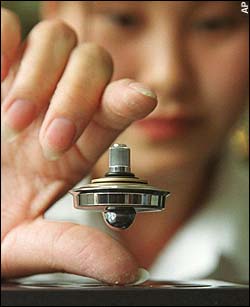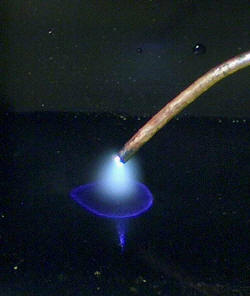| Nikola Tesla made his first discoveries and inventions on the eighties of the last century. Searching for a noncommutator motor which would have eliminated major defects of Graham's direct current motor, in 1882 Tesla brilliantly invented the multiphase alternating current induction motor. At the same time this motor was the solution which made long-distance energy transmission possible, due to the possibility of transforming alternating currents into high voltage for more efficient transmission and low voltage for practical use.
In the following two years Tesla made futile efforts to arouse interest in European experts and ensure funds for realization of the new system of electric power generation, transmission and utilization. Finally, in 1884, he went to the USA with the recommendation from his employer in Edison's Paris branch. Edison, who was already famous and rich owing to his numerous patents and a series of inventions, immediately offered a job to Tesla, but was not interested in his alternating current, system. So their brief encounter ended and Tesla went his own way without Edison's encouragement and understanding.
After a seven-year break Tesla recommenced applying for patents, but this time in the field of turbines, pumps, fluids, lightning protectors, flow-meters and speed indicators. The majority of these patents were applied for in 1916. 'The last two patents Tesla applied for in the USA in 1921 and 1927 were in the domain of avionics.
The total number of patents issued to Nikola Tesla in the USA according to the evidence of the Nikola Tesla Museum in Belgrade amounted to 112. Here are 113 you can read by downloading the Acrobat files Plus additional British and Canadian Patents you never heard of:
- US Patent 11,865 Method Of Insulating Electric Conductors
- US Patent 334,823 Commutator For Dynamo-Electric Machines
- US Patent 335,786 Electric-Arc Lamp
- US Patent 335,787 Electric-Arc Lamp
- US Patent 336,961 Regulator For Dynamo-Electric Machines
- US Patent 336,962 Regulator For Dynamo-Electric Machines
- US Patent 350,954 Regulator For Dynamo-Electric Machines
- US Patent 359,748 Dynamo-Electric Machine
- US Patent 381,968 Electro-Magnetic Motor
- US Patent 381,969 Electro-Magnetic Motor
- US Patent 381,970 System Of Electrical Distribution
- US Patent 382,279 Electro-Magnetic Motor
- US Patent 382,280 Electrical Transmission Of Power
- US Patent 382,281 Electrical Transmission Of Power
- US Patent 382,282 Method Of Converting And Distributing Electric Currents
- US Patent 382,845 Commutator For Dynamo-Electric Machines
- US Patent 390,413 System Of Electrical Distribution
- US Patent 390,414 Dynamo-Electric Machine
- US Patent 390,415 Dynamo-Electric Machine Or Motor
- US Patent 390,721 Dynamo-Electric Machine
- US Patent 390,820 Regulator For Alternate-Current Motors
- US Patent 396,121 Thermo-Magnetic Motor
- US Patent 401,520 Method Of Operating Electro-Magnetic Motors
- US Patent 405,858 Electro-Magnetic Motor
- US Patent 405,859 Method Of Electrical Power Transmission
- US Patent 406,968 Dynamo-Electric Machine
- US Patent 413,353 Method Of Obtaining Direct From Alternating Currents
- US Patent 416,191 Electro-Magnetic Motor
- US Patent 416,192 Method Of Operating Electro-Magnetic Motors
- US Patent 416,193 Electro-Magnetic Motor
- US Patent 416,194 Electric Motor
- US Patent 416,195 Electro-Magnetic Motor
- US Patent 417,794 Armature For Electric Machines
- US Patent 418,248 Electro-Magnetic Motor
- US Patent 424,036 Electro-Magnetic Motor
- US Patent 428,057 Pyromagneto-Electric Generator
- US Patent 433,700 Alternating-Current Electro-Magnetic Motor
- US Patent 433,701 Alternating-Current Motor
- US Patent 433,702 Electrical Transformer Or Induction Device
- US Patent 433,703 Electro-Magnetic Motor
- US Patent 445,207 Electro-Magnetic Motor
- US Patent 447,920 Method Of Operating Arc-Lamps
- US Patent 447,921 Alternating Electric Current Generator
- US Patent 454,622 System Of Electric Lighting
- US Patent 455,067 Electro-Magnetic Motor
- US Patent 455,068 Electrical Meter
- US Patent 455,069 Electric Incandescent Lamp
- US Patent 459,772 Electro-Magnetic Motor
- US Patent 462,418 Method Of And Apparatus For Electrical Conversion And Distribution
- US Patent 464,666 Electro-Magnetic Motor
- US Patent 464,667 Electrical Condenser
- US Patent 487,796 System Of Electrical Transmission Of Power
- US Patent 511,559 Electrical Transmission Of Power
- US Patent 511,560 System Of Electrical Power Transmission
- US Patent 511,915 Electrical Transmission Of Power
- US Patent 511,916 Electric Generator
- US Patent 512,340 (HTML) Coil For Electro-magnets
- US Patent 512,340 (PDF) Coil For Electro-Magnets
- US Patent 514,167 Electrical Conductor
- US Patent 514,168 Means For Generating Electric Currents
- US Patent 514,169 Reciprocating Engine
- US Patent 514,170 Incandescent Electric Light
- US Patent 514,972 Electric Railway System
- US Patent 514,973 Electrical Meter
- US Patent 517,900 Steam Engine
- US Patent 524,426 Electromagnetic Motor
- US Patent 555,190 Alternating Motor
- US Patent 567,818 Electrical Condenser
- US Patent 568,176 Apparatus For Producing Electric Currents Of High Frequency And Potential
- US Patent 568,177 Apparatus For Producing Ozone
- US Patent 568,178 Method Of Regulating Apparatus For Producing Electric Currents Of High Frequency
- US Patent 568,179 Method Of And Apparatus For Producing Currents Of High Frequency
- US Patent 568,180 Apparatus For Producing Electrical Currents Of High Frequency
- US Patent 577,670 Apparatus For Producing Electric Currents Of High Frequency
- US Patent 577,671 Manufacture Of Electrical Condensors, Coils And Similar Devices
- US Patent 583,953 Apparatus For Producing Currents Of High Frequency
- US Patent 593,138 Electrical Transformer
- US Patent 609,245 Electrical Circuit Controller
- US Patent 609,246 Electric Circuit Controller
- US Patent 609,247 Electric Circuit Controller
- US Patent 609,248 Electric Circuit Controller
- US Patent 609,249 Electric Circuit Controller
- US Patent 609,250 Electrical Igniter For Gas Engines
- US Patent 609,251 Electric Circuit Controller
- US Patent 611,719 Electrical Circuit Controller
- US Patent 613,735 Electric Circuit Controller
- US Patent 613,809 Method Of And Apparatus For Controlling Mechanism Of Moving Vessels Or Vehicles
- US Patent 645,576 System Of Transmission Of Electrical Energy
- US Patent 649,621 Apparatus For Transmission Of Electrical Energy
- US Patent 655,838 Method Of Insulating Electric Conductors
- US Patent 685,012 Means For Increasing The Intensity Of Electrical Oscillations
- US Patent 685,953 Method Of Intensifying And Utilizing Effects Transmitted Through Natural Media
- US Patent 685,954 Method Of Utilizing Effects Transmitted Through Natural Media
- US Patent 685,955 Apparatus For Utilizing Effects Transmitted From A Distance To A Receiving Device Through Natural Media
- US Patent 685,956 Apparatus For Utilizing Effects Transmitted Through Natural Media
- US Patent 685,957 Apparatus For The Utilization of Radiant Energy
- US Patent 685,958 Method Of Utilizing of Radiant Energy
- US Patent 723,188 Method Of Signaling
- US Patent 725,605 System Of Signaling
- US Patent 787,412 Art Of Transmitting Electrical Energy Through The Natural Mediums
- US Patent 1,061,142 Fluid Propulsion
- US Patent 1,061,206 Turbine
- US Patent 1,113,716 Fountain
- US Patent 1,119,732 Apparatus For Transmitting Eleectrical Energy
- US Patent 1,209,359 Speed Indicator
- US Patent 1,266,175 Lightning Protector
- US Patent 1,274,816 Speed Indicator
- US Patent 1,314,718 Ship's Log
- US Patent 1,329,559 Valvular Conduit
- US Patent 1,365,547 Flow Meter
- US Patent 1,402,025 Frequency Meter
- US Patent 1,655,113 Method Of Aerial Transportation
- US Patent 1,655,114 Apparatus For Aerial Transportation
- British Patent 1,877 Improvements in Electric Lamps
- British Patent 2,801 Improvements in Reciprocating Engines and Means for Regulating the Period of the same
- British Patent 2,812 Improvements in Methods of and Apparatus for the Generation of Electric Currents of Defined Period
- British Patent 2,975 Improvements in Dynamo Electric Machines
- British Patent 6,481 Improvements relating to the Electrical Transmission of Power and to Apparatus therefor
- British Patent 6,502 Improvements relating to the Generation and Distribution of Electric Currents and to Apparatus therefor
- British Patent 6,527 Improvements relating to Electro-motors
- British Patent 8,200 Improvements relating to the Transmission of Electrical Energy
- British Patent 8,575 Improved Methods of and Apparatus for Generating and Utilizing Electric Energy for Lighting Purposes
- British Patent 11,293 Improvements relating to the Utilization of Electromagnetic, Light, or other like Radiations Effects or Disturbances transmitted through the Natural Media and to Apparatus therefor
- British Patent 11,473 Improvements in Alternating Current Electro-magnetic Motors
- British Patent 13,563 Improvements in, and relating to, the Transmission of Electrical Energy
- British Patent 14,550 Improvements relating to the Insulation of Electric Conductors
- British Patent 14,579 Improvements in and relating to the Transmission of Electrical Energy
- British Patent 16,709 Improvements relating to the Conversion of Alternating into Direct Electric Currents
- British Patent 19,420 Improvements in Alternating Current Electro-magnetic Motors
- British Patent 19,426 Improvements in the Construction and Mode of Operating Alternating Current Motors
- Canadian Patent 24,033 Improvements in Dynamo Electric Machines
- Canadian Patent 29,537 Improvements in Methods of and Apparatus for the Electrical Transmission of Power
- Canadian Patent 30,172 Improvements in Methods of and Apparatus for Converting and Distributing Electric Currents
- Canadian Patent 33,317 Improvements in Methods and Apparatus for Converting Alternating into Direct Currents
- Canadian Patent 135,174 Improvements in Fluid Propulsion (Tesla Pump)
- Canadian Patent 142,352 Improvement in the Art of Transmitting Electrical Energy Through the Natural Mediums
Other pages on Tesla: Article, Biography Part One, Biography Part Two, Patents, Photographs, Statue, Transmitter
Other biographies: Aldini, Ampère, Arrhenius, Avogadro, Bacon, Berzelius, Boltzmann, Boyle, Bunsen, Callan, Carnot, Cavendish, Coulomb, Daniell, Davy, Debye, Dillon, Dow, Edison, Einstein, Evans, Faraday, Fick, Fontana, Franklin, Galvani, Gauss, Gibbs, Gilbert, Grove, Guericke, Hall, Helmholtz, Héroult, Hertz, Hoar, Joule, LaQue, Leclanché, Mendeleev, Millikan, Musschenbroek, Nernst, Newton, Ohm, Ørsted, Parkins, Planté, Poisson, Pourbaix, Reynolds, Ritter, Speller, Stokes, Tesla, Thomson, Uhlig, Volta, Watt, Weston
|










